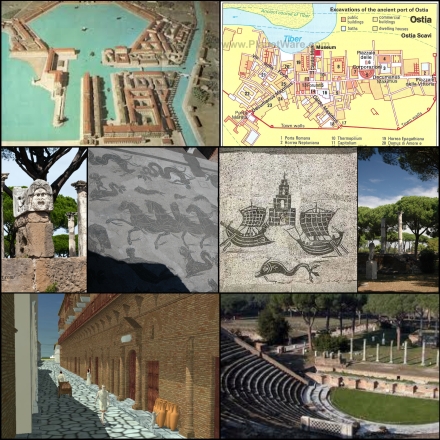Ostia was a harbor city of the Ancient Roman Empire. Located just west of the heart of the empire, the city acted as a main port and trading center. The construction of Ostia reflects the typical design of ancient cities while incorporating its own unique elements. The city had few of its own natural resources and as a result relied on trade to support its citizens and the empire. Ostia is located at the mouth of the Tiber river allowing easy transportation of goods to the city of Rome and other parts of the empire. Roads have been found running South- East starting at the Tiber to further facilitate trade (ostia-antica.org). Large harbor basins, like the hexagonal one in the picture, were built to house those ships that could not travel down the Tiber to Rome. With the capacity to house hundreds of ships at a time, the city was able to flourish taxing imported goods such as grain. Ostia was not simply a harbor but a complete city with a developed culture. For example, the city had a local government and developed a series of important guilds or craftsmen and merchant associations. In keeping with the popular culture of the time the city also had a large theater built by Marcus Agrippa equpied to hold three thousand people. A great deal of artwork, such as paintings and mosaics, have been found in the area and are representative of the city’s purpose and values. For example, one of the images given to us depicts two large ships perhaps because at one point the city acted primarily and a naval base. We learned in class that contrary to popular belief urbanism is not a product of the agricultural revolution which can be seen in the major success of cities such as Ostia. Although increased agricultural yield is what allowed cities like Ostia to flourish, just like that of lots of other major cities,its success hinged on it proximity or access to a natural resource. Through innovation, agriculture was made possible in the hinterland of many major cities and through advances in technology goods could be transported all over the empire. Cities were developed based on function and specialization began to develop along with increased trade. Empires were first created as a result of cities taking other city’s surplus land. The greek empire was a first of its kind as it obtained a great deal of land but only in costal areas and without the technology to move inward they were confined to the use of sea transportation. The greeks were the first to develop an ideal urban model which can be seen all over the mediterranean. The Romans expanded on the Greek urban plan with the invention of things such as the road which opened up the hinterlands and allowed reliable trade. They expanded on the model of the gridded city which can be seen in the pictures given to us as a portion of the city follows this pattern with some additional elements. The city includes other aspects of traditional ancient cities such as the roman street system including a cardo maximus and decumanus maximus and the use of columns to convey order, structure, and power. The population of Rome eventually reached one million through its ability to draw on resources from the entire empire including the city of Ostia which managed to maintained its own unique identity at the same time.

Please reblog this and write 500 words of discussion about what you see and how it relates to the lecture we had on classical and ancient cities last week. Your thoughts should be posted by midnight on Sunday January 26th. Feel free to comment on each others’ posts…